Microstructures and Mechanical Properties of Laser-Sintered Commercially Pure Ti and Ti-6Al-4V Alloy for Dental Applications
Abstract
:1. Introduction
2. Experimental Procedure
2.1. Test Specimens
2.1.1. Laser Sintering and Dental Casting
2.1.2. Laser-Sintered Powders and Ti Material Rods
2.2. Evaluation of Physical Properties
2.3. Microstructural Observation
2.4. Static Immersion Test
2.5. Room-Temperature Tensile Tests
2.6. Fatigue Tests
3. Results and Discussion
3.1. Chemical Compositions and Physical Properties
3.2. Microstructure of Laser-Sintered Ti Materials
3.3. Mechanical Properties of Laser-Sintered Ti Materials
3.4. Fatigue Strengths of Laser-Sintered Ti Materials
4. Conclusions
Author Contributions
Funding
Acknowledgments
Conflicts of Interest
References
- Okazaki, Y.; Ishino, A.; Higuchi, S. Chemical, physical, and mechanical properties and microstructures of laser-sintered Co–25Cr–5Mo–5W (SP2) and W-free Co–28Cr–6Mo alloys for dental application. Materials 2019, 12, 4039. [Google Scholar] [CrossRef] [PubMed] [Green Version]
- Nakata, T.; Shimpo, H.; Ohkubo, C. Clasp fabrication using one-process molding by repeated laser sintering and high-speed milling. J. Prosthodont. Res. 2017, 61, 276–282. [Google Scholar] [CrossRef] [PubMed]
- Takaichi, A.; Suyalatu; Nakamoto, T.; Joko, N.; Nomura, N.; Tsutumi, Y.; Migita, S.; Doi, H.; Kurosu, S.; Chiba, A.; et al. Microstructures and mechanical properties of Co–29Cr–6Mo alloy fabricated by selective laser melting process for dental applications. J. Mech. Behav. Biomed. Mater. 2013, 21, 67–76. [Google Scholar] [CrossRef] [PubMed]
- Implants for Surgery–Metallic Materials–Part 2: Unalloyed Titanium, ISO 5832–2; International Organization for Standardization: Geneva, Switzerland, 2018.
- Implants for Surgery–Metallic Materials–Part 3: Wrought Titanium 6–Aluminum 4–Vanadium Alloy, ISO 5832–3; International Organization for Standardization: Geneva, Switzerland, 2016.
- O’Leary, R.; Setchi, R.; Prickett, P.; Hankins, G.; Jones, N. An investigation into the recycling of Ti–6Al–4V powder used within SLM to improve sustainability. In Proceedings of the 2nd International Conference on Sustainable Design and Manufacturing, Seville, Spain, 12–14 April 2015; pp. 377–388. Available online: http://orca.cf.ac.uk/id/eprint/81260 (accessed on 10 January 2020).
- Standard Specification for Additive Manufacturing Titanium–6 Aluminum–4 Vanadium with Powder Bed Fusion, ASTM F 2924; American Society for Testing and Materials: West Conshohocken, PA, USA, 2014.
- Lin, C.W.; Ju, C.P.; Lin, J.H.C. Comparison among mechanical properties of investment-cast C.P. Ti, Ti-6Al-7Nb and Ti-15Mo-1Bi alloys. Mater. Trans. 2004, 45, 3028–3032. [Google Scholar] [CrossRef] [Green Version]
- Takahashi, M.; Kikuchi, M.; Takada, Y.; Okuno, O. Mechanical properties and microstructures of dental cast Ti-Ag and Ti-Cu alloys. Dent. Mater. J. 2002, 21, 270–280. [Google Scholar] [CrossRef] [PubMed] [Green Version]
- Koizumi, H.; Ishii, T.; Okazaki, T.; Kaketani, M.; Matumura, H.; Yoneyama, T. Castability and mechanical properties of Ti-15Zr-5Zr-3Al alloy in dental casting. J. Oral Sci. 2018, 60, 285–292. [Google Scholar] [CrossRef] [PubMed] [Green Version]
- Tamaki, Y.; Miyazaki, T. Problems on titanium castings for clinical use. J. Jpn. Prosthodont. Soc. 1998, 42, 528–539. [Google Scholar] [CrossRef] [Green Version]
- Ida, K.; Togaya, T.; Tsutsumi, S.; Takeuchi, M. Effect of magnesia investments in the dental casting of pure titanium or titanium alloys. Dent. Mater. J. 1982, 1, 8–21. [Google Scholar] [CrossRef] [PubMed]
- Collings, E.W.; Boyer, R.; Welsch, G.; Collings, E.W. (Eds.) ASM Materials Properties Handbook: Classification of Titanium Alloys; The Materials Information Society: Materials Park, OH, USA, 1994; p. 5. [Google Scholar]
- Okazaki, Y. Development of low-cost manufacturing process and effects of adding small amounts of Ta, O, and N on the physical and mechanical properties of highly biocompatible Ti alloys. Mater. Trans. 2019, 60, 1769–1778. [Google Scholar] [CrossRef]
- Particle Size Analysis–Laser Diffraction Methods, ISO 13332; International Organization for Standardization: Geneva, Switzerland, 2009.
- Titanium and Titanium Alloys–Determination of Hydrogen Content, JIS H 1619; Japanese Standards Association: Tokyo, Japan, 2012.
- Methods for Determination of Nitrogen in Titanium and Titanium Alloys, JIS H 1612; Japanese Standards Association: Tokyo, Japan, 1993.
- Methods for Determination of Oxygen in Titanium and Titanium Alloys, JIS H 1620; Japanese Standards Association: Tokyo, Japan, 1995.
- Methods for Determination of Iron in Titanium and Titanium Alloys, JIS H 1614; Japanese Standards Association: Tokyo, Japan, 1995.
- Methods for Determination of Carbon in Titanium and Titanium Alloys, JIS H 1617; Japanese Standards Association: Tokyo, Japan, 1995.
- Titanium Alloys−Methods for Determination of Aluminium, JIS H 1622; Japanese Standards Association: Tokyo, Japan, 1998.
- Titanium Alloys–Method for Determination of Vanadium, JIS H 1624; Japanese Standards Association: Tokyo, Japan, 2005.
- Testing Methods for Particle Density of Fine Ceramic Powder, JIS R 1620; Japanese Standards Association: Tokyo, Japan, 1995.
- Dentistry–Corrosion Test Methods for Metallic Materials, ISO 10271; International Organization for Standardization: Geneva, Switzerland, 2011.
- Dental Casting Cobalt Chromium Alloys, JIS T 6115; Japanese Standards Association: Tokyo, Japan, 2013.
- Dentistry–Metallic Materials for Fixed and Removable Restorations and Appliances, ISO 22674; International Organization for Standardization: Geneva, Switzerland, 2016.
- Metallic Materials–Tensile Testing–Method of Test at Room Temperature, JIS Z 2241; Japanese Standards Association: Tokyo, Japan, 2011.
- Test Method for Fatigue Properties of Metallic Biomaterials, JIS T 0309; Japanese Standards Association: Tokyo, Japan, 2009.
- Boyer, R.; Welsch, G.; Collings, E.W. (Eds.) ASM Materials Properties Handbook: Titanium Data Sheets; The Materials Information Society: Materials Park, OH, USA, 1994. [Google Scholar]
- Okazaki, Y.; Nagata, H. Comparisons of immersion and electrochemical properties of highly biocompatible Ti–15Zr–4Nb–4Ta alloy and other implantable metals for orthopedic implants. Sci. Technol. Adv. Mater. 2012, 13, 064216. [Google Scholar] [CrossRef] [PubMed] [Green Version]
- Simonell, M.; Tse, Y.Y.; Tuck, C. Microstructure of Ti–6Al–4V produced by selective laser melting. J. Phys. Conf. Ser. 2012, 371, 012084. [Google Scholar] [CrossRef] [Green Version]
- Rafi, H.K.; Karthik, N.V.; Gong, H.; Starr, T.L.; Stucker, B.E. Microstructures and mechanical properties of Ti6Al4V parts fabricated by selective laser melting and electron beam melting. J. Mater. Eng. Perform. 2013, 22, 3872–3883. [Google Scholar] [CrossRef]
- Haar, G.M.T.; Becker, T.H. Selective laser melting produced Ti–6Al–4V: Post-process heat treatment to achieve superior tensile properties. Materials 2018, 11, 146. [Google Scholar] [CrossRef] [PubMed] [Green Version]
- Facchini, L.; Molinari, A.; öges, S.H.; Wissenbach, K. Ductility of a Ti–6Al–4V alloy produced by selective laser melting of prealloyed powders. Rapid Prototyp. J. 2010, 16, 450–459. [Google Scholar] [CrossRef]
- Qiu, C.; Adkins, N.J.E.; Attallah, M.M. Microstructure and tensile properties of selectively laser-melted and HIPed laser-melted Ti–6Al–4V. Mater. Sci. Eng. A 2013, 578, 230–239. [Google Scholar] [CrossRef]
- Vrancken, B.; Thijs, L.; Kruth, J.P.; Humbeeck, J.V. Heat treatment of Ti6Al4V produced by selective laser melting: Microstructure and mechanical properties. J. Alloys Compd. 2012, 541, 177–185. [Google Scholar] [CrossRef] [Green Version]
- Gong, H.; Rafi, K.; Gu, H.; Ram, G.D.J.; Starr, T.; Stucker, B. Influence of defects on mechanical properties of Ti–6Al–4V components produced by selective laser melting and electron beam melting. Mater. Des. 2015, 86, 545–554. [Google Scholar] [CrossRef]
- Leuders, S.; Thöne, M.; Riemer, A.; Niendorf, T.; Tröster, T.; Richard, H.A.; Maier, H.J. On the mechanical behaviour of titanium alloy TiAl6V4 manufactured by selective laser melting: Fatigue resistance and crack growth performance. Int. J. Fatigue 2013, 48, 300–307. [Google Scholar] [CrossRef]
- Okazaki, Y.; Gotoh, E. Comparison of fatigue strengths of biocompatible Ti–15Zr–4Nb–4Ta alloy and other titanium materials. Mater. Sci. Eng. C 2011, 33, 325–333. [Google Scholar] [CrossRef]
- Okazaki, Y. On the effects of hot forging and hot rolling on the microstructural development and mechanical response of a biocompatible Ti alloy. Materials 2012, 5, 1439–1461. [Google Scholar] [CrossRef]
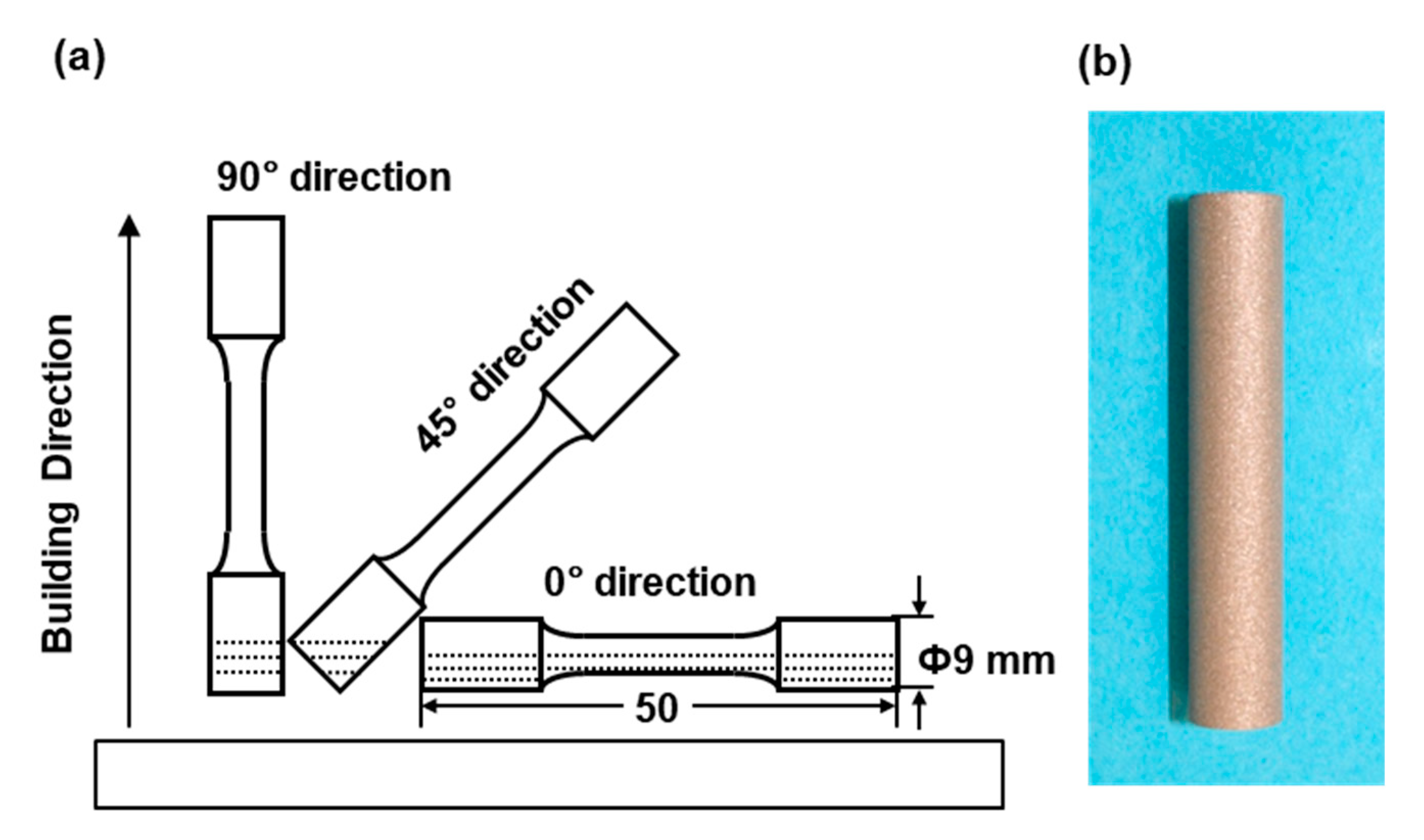
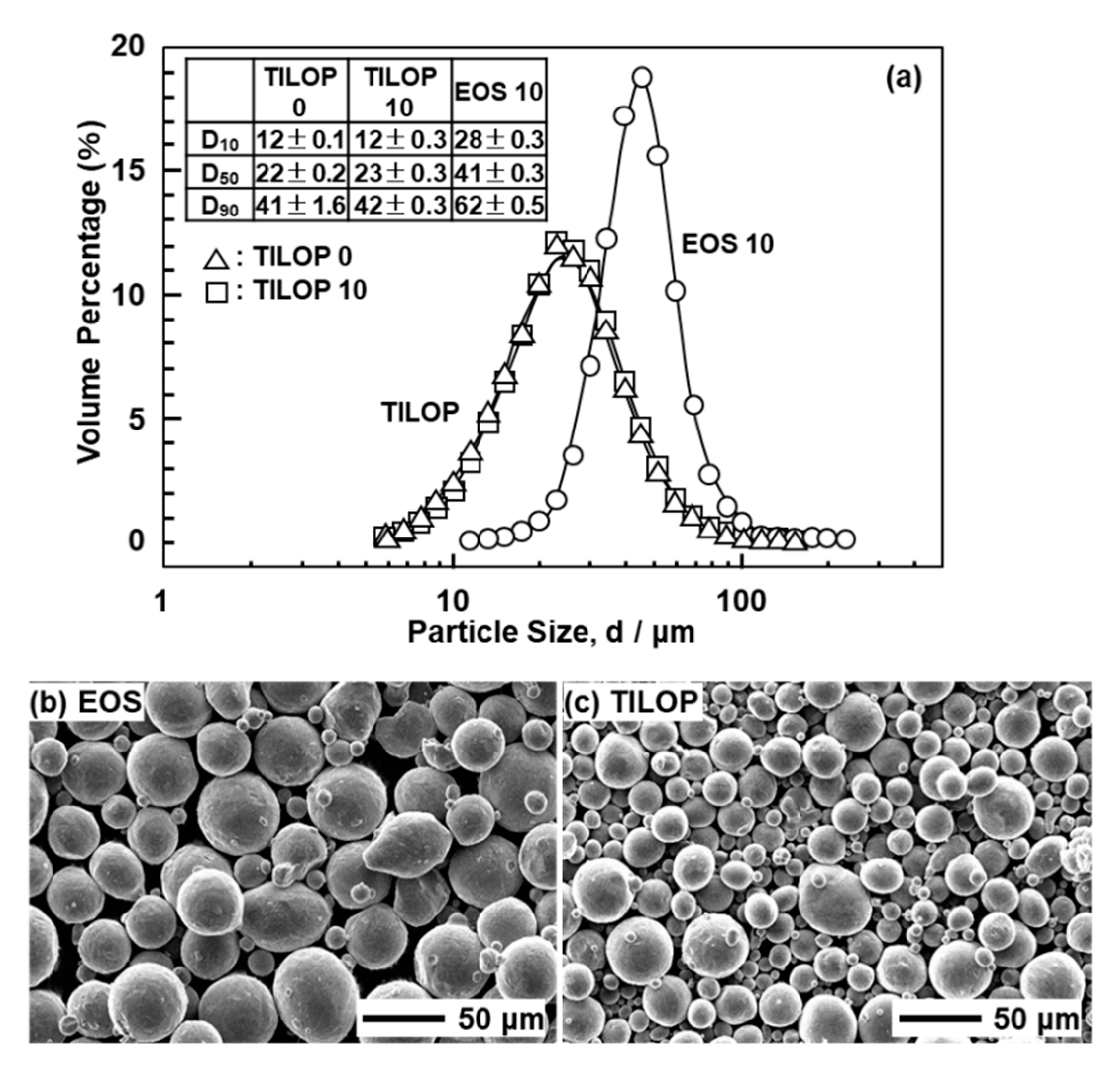
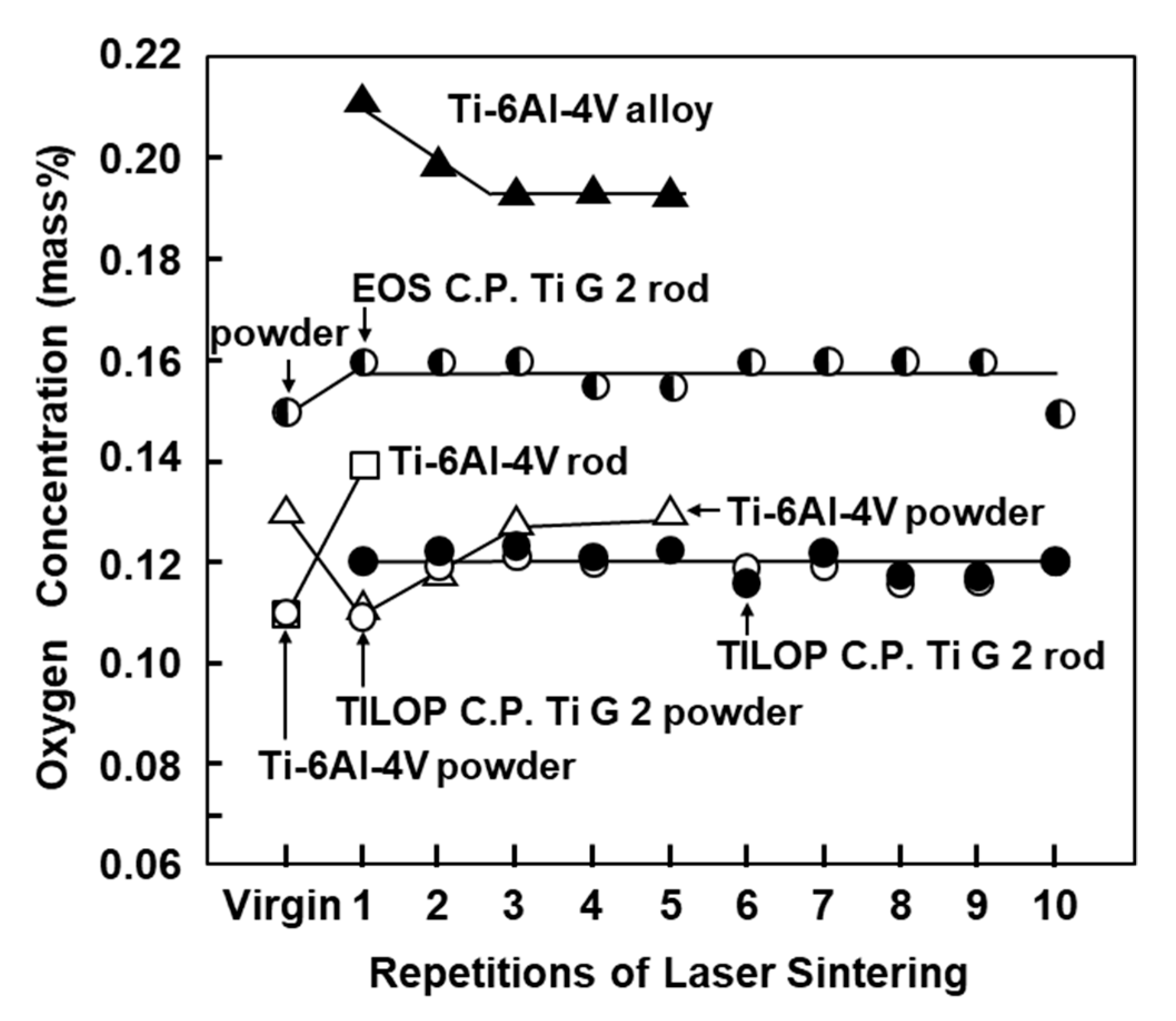


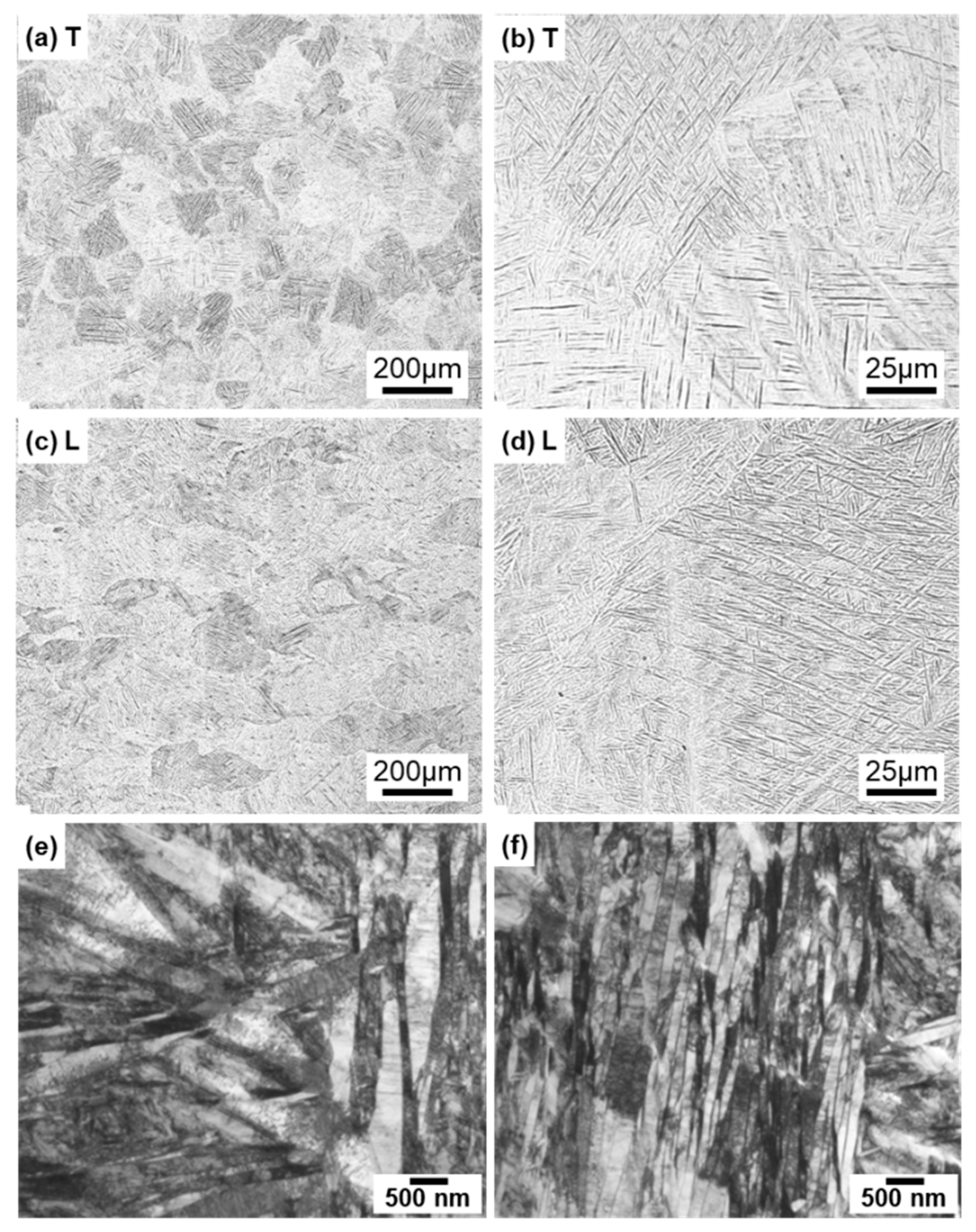
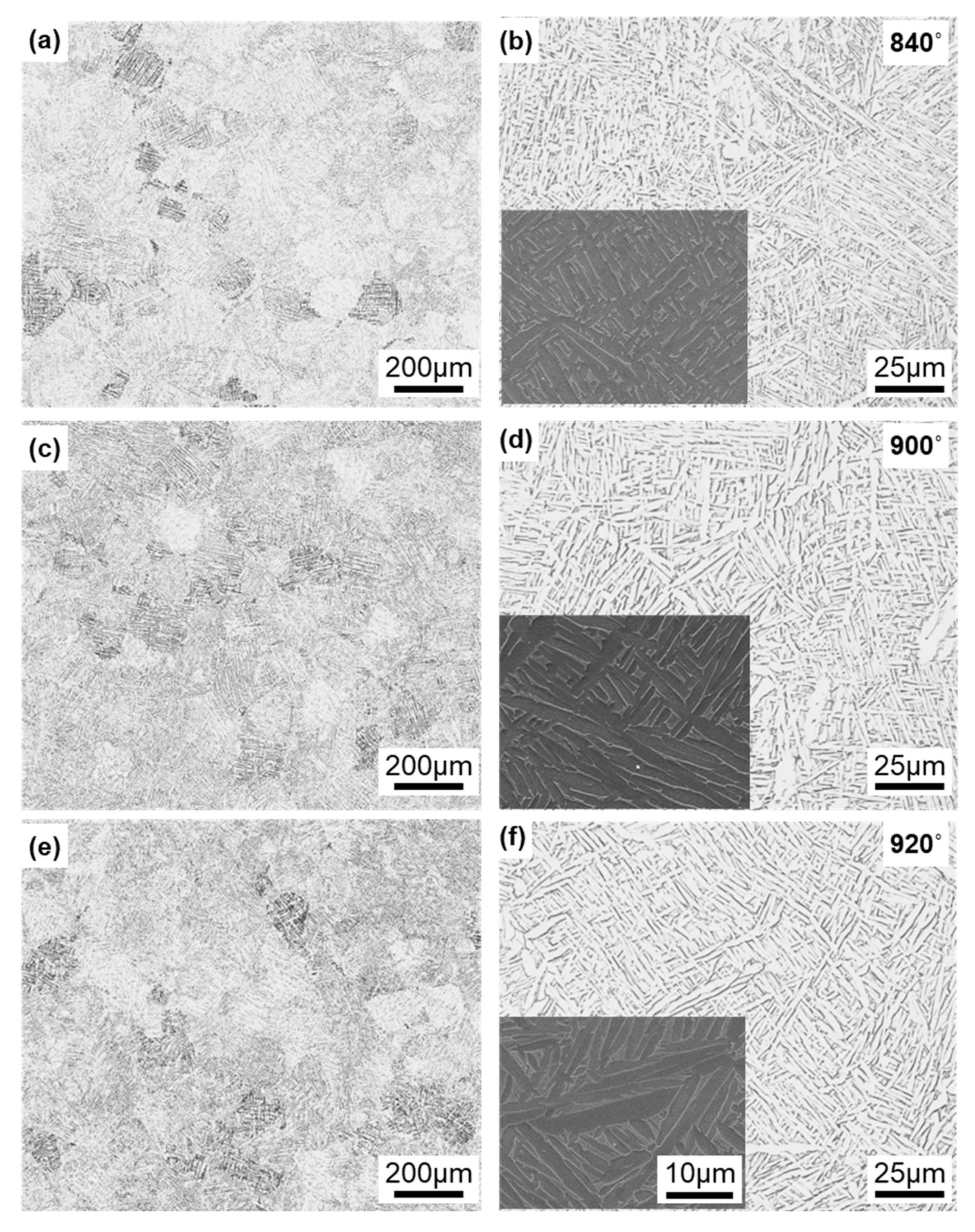




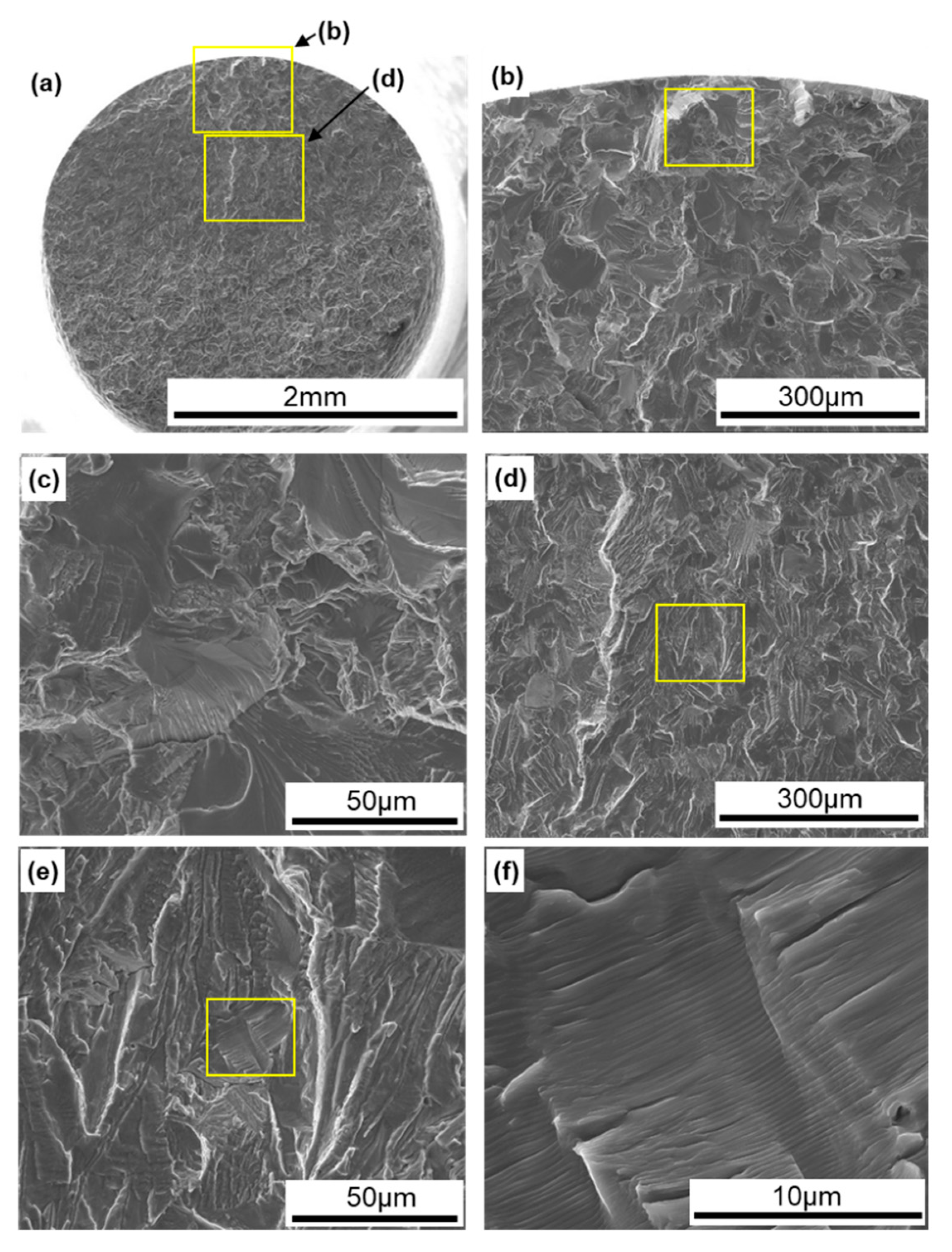
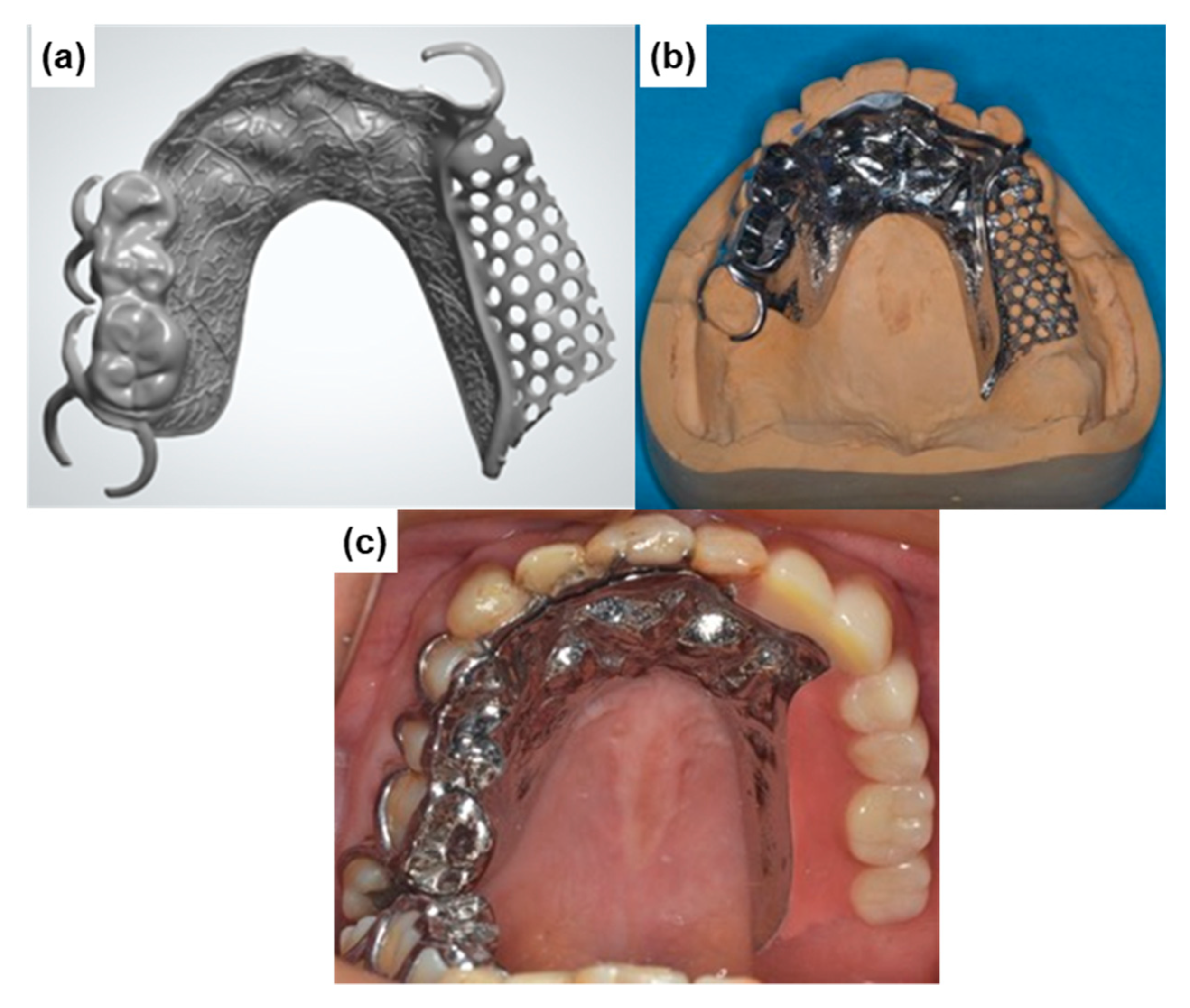
| Alloy | Al | V | Fe | O | N | H | C | Ti |
|---|---|---|---|---|---|---|---|---|
| EOS CP Ti G 2 virgin powder | 0.16 | 0.15 | 0.01 | 0.002 | 0.01 | Bal. | ||
| 10-times-sintered powder | 0.17 | 0.15 | 0.008 | 0.0013 | 0.009 | Bal. | ||
| 10-times-sintered CP Ti G 2 rod | 0.17 | 0.16 | 0.017 | 0.0014 | 0.008 | Bal. | ||
| TILOP CP Ti G 2 virgin powder | 0.015 | 0.11 | <0.005 | 0.0037 | 0.005 | Bal. | ||
| 10-times-sintered CP Ti powder | 0.015 | 0.12 | 0.006 | 0.0035 | 0.005 | Bal. | ||
| Once-sintered CP Ti G 2 rod | 0.02 | 0.12 | 0.009 | 0.0032 | 0.002 | Bal. | ||
| 10-times-sintered CP Ti G 2 rod | 0.02 | 0.12 | 0.007 | 0.0037 | 0.004 | Bal. | ||
| Dental-cast CP Ti G 2 rod | 0.103 | 0.17 | 0.007 | 0.0022 | 0.007 | Bal. | ||
| Ti-6Al-4V powder | 6.05 | 3.89 | 0.21 | 0.11 | 0.003 | 0.002 | 0.006 | Bal. |
| Laser-sintered Ti-6Al-4V rod | 5.93 | 3.91 | 0.20 | 0.14 | 0.022 | 0.002 | 0.007 | Bal. |
| Specimen | σ0.2%PS /MPa | σUTS /MPa | TE (%) | RA (%) | σFS /MPa | σFS /σUTS |
|---|---|---|---|---|---|---|
| EOS CP Ti G 2 | ||||||
| Once-sintered 90° | 412 ± 2 | 553 ± 3 | 26 ± 1 | 59 ± 1 | 320 | 0.58 |
| 10-times-sintered 0° | 437 ± 2 | 576 ± 1 | 28 ± 2 | 55 ± 1 | 365 | 0.63 |
| 10-times-sintered 90° | 426 ± 1 | 565 ± 1 | 25 ± 1 | 56 ± 1 | 320 | 0.57 |
| TILOP CP Ti G 2 | ||||||
| Once-sintered 90° | 445 ± 2 | 578 ± 3 | 27 ± 5 | 36 ± 10 | 330 | 0.57 |
| Once-sintered 0° | 432 ± 6 | 576 ± 5 | 26 ± 3 | 50 ± 1 | 380 | 0.66 |
| Once-sintered 45° | 419 ± 4 | 557 ± 3 | 22 ± 5 | 47 ± 6 | 290 | 0.52 |
| 10-times-sintered 90° | 371 ± 4 | 481 ± 6 | 22 ± 8 | 41 ± 14 | 340 | 0.71 |
| Dental-cast CP Ti G 2 | 351 ± 2.2 | 466 ± 3 | 30 ± 6 | 68 ± 5 | 290 | 0.62 |
| Wrought CP Ti G 2 | 276 ± 6 | 410 ± 4 | 40 ± 2 | 60 ± 6 | 280 | 0.68 |
| Laser-sintered Ti-6Al-4V | 1171 ± 3 | 1305 ± 2 | 13 ± 1 | 31 ± 3 | 600 | 0.46 |
| Wrought Ti-6Al-4V | 849 ± 1 | 934 ± 1 | 16 ± 1 | 42 ± 3 | 680 | 0.73 |
| ISO 5832-4 | ≥275 | ≥345 | ≥20 |
© 2020 by the authors. Licensee MDPI, Basel, Switzerland. This article is an open access article distributed under the terms and conditions of the Creative Commons Attribution (CC BY) license (http://creativecommons.org/licenses/by/4.0/).
Share and Cite
Okazaki, Y.; Ishino, A. Microstructures and Mechanical Properties of Laser-Sintered Commercially Pure Ti and Ti-6Al-4V Alloy for Dental Applications. Materials 2020, 13, 609. https://doi.org/10.3390/ma13030609
Okazaki Y, Ishino A. Microstructures and Mechanical Properties of Laser-Sintered Commercially Pure Ti and Ti-6Al-4V Alloy for Dental Applications. Materials. 2020; 13(3):609. https://doi.org/10.3390/ma13030609
Chicago/Turabian StyleOkazaki, Yoshimitsu, and Akira Ishino. 2020. "Microstructures and Mechanical Properties of Laser-Sintered Commercially Pure Ti and Ti-6Al-4V Alloy for Dental Applications" Materials 13, no. 3: 609. https://doi.org/10.3390/ma13030609






